Oz-e-science - Biology
Foundation – Year 6
Oz-e-science Biology units align to the Australian Curriculum Content Descriptions.
Share this page:
Starter Lessons
Year Overview
Foundation Year
Year F, Lesson 1
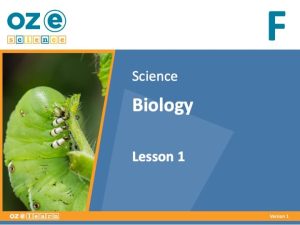
Year F, Lesson 2

Teaching Resources
Extra resources
Australian Curriculum Content Descriptions
Overview
Biology Foundation Year is a Biological Sciences unit for Foundation Year students.
It aligns with the Australian Curriculum Science Understanding:
Observe external features of plants and animals and describe ways they can be grouped based on these features. (AC9SFU01)
Learning Objectives
In lessons 1 to 10, students learn:
- that humans are animals
- how animals smell and take food and water to live and grow
- how animals see and hear
- how animals move
- about Animal Groups
- how plants breathe and make food
- how plants take food and water through their roots and have trunks and branches
- about the Plant Family Branch
- about the Tree of Life
- review what we learned about plants and animals.
Success Criteria
- Explain that humans are animals.
- Represent a model of a human organism.
- Explain how animals smell and take food and water to live and grow.
- Role play how animals use their sense of smell to find food.
- Explain how animals see and hear.
- Investigate different ways humans can see and hear things.
- Explain how animals move.
- Observe how animals move and how different animals move to survive.
- Identify animal groups.
- Sort animals into groups.
- Explain how plants breathe and make food.
- Observe how plants breathe and make food.
- Explain how plants take food and water through their roots and have trunks and branches.
- Observe how plants grow from seeds.
- Identify plant family groups.
- Observe a tree near the school.
- Describe the Tree of Life.
- Represent the Tree of Life.
Assessment
End-of-Unit Assessment
The last lesson is the End-of-Unit Assessment, which has a variety of question formats (e.g., label the diagram, and circle the correct answer) to assess student mastery of content from the unit.
The End-of-Unit Assessment is in the Teaching Guide. Teachers copy the assessment and distribute it to students at testing time.
Year 1
Year 1, Lesson 1
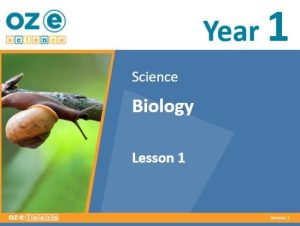
Year 1, Lesson 2
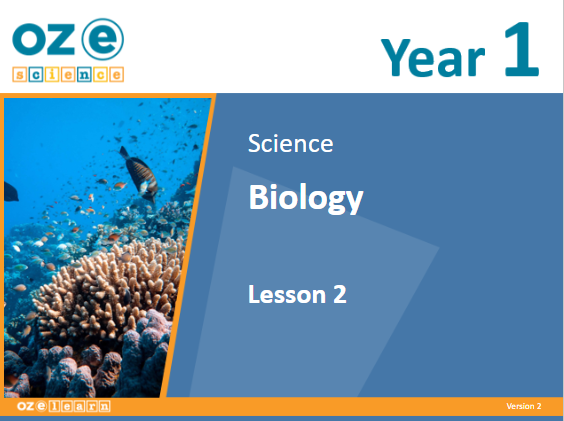
Teaching Resources
Extra resources
Australian Curriculum Content Descriptions
Overview
Biology Foundation Year is a Biological Sciences unit for Foundation Year students.
It aligns to the Australian Curriculum Science Understanding:
Identify the basic needs of plants and animals, including air, water, food, and shelter, and describe how the places they live meet those needs. (AC9S1U01)
Learning Objectives
In lessons 1 to 10, students learn about:
- how plants and animals have basic needs
- how plants and animals live in habitats
- the basic needs of plants on land and their habitats
- the basic needs of plants in water and their habitats
- the basic needs of animals on land and their habitats
- the basic needs of animals in water and their habitats
- plant and animal habitats according to season and climate
- one of the most resilient organisms in the world – tardigrades – and how they meet their basic needs and the habitats in which they live
- investigating local flora and fauna.
Success Criteria
• Explain that plants and animals have basic needs.
• Represent the basic needs of plants and animals.
• Explain that plants and animals live in habitats.
• Sort animals and plants based on their habitat.
• Explain the basic needs of plants on land and their habitats.
• Observe the growth of plants in different pots.
• Explain the basic needs of plants in water and their habitats.
• Represent a water habitat.
• Explain the basic needs of animals on land and their habitats.
• Investigate how animals meet their needs at a nearby park.
• Explain the basic needs of animals in water and their habitats.
• Observe water animals in their habitats.
• Explain plant and animal habitats according to season and climate.
• Represent plant and animal habitats according to season and climate.
• Explain how tardigrades meet their basic needs and the habitats in which they live.
• Represent a tardigrade.
• Investigate local flora and fauna.
Assessment
Progress Tests
Progress tests are conducted after every second lesson, allowing teachers to monitor student understanding of the concepts taught over the past two lessons and identify where reteaching is needed. The Teaching Guide contains the testing questions, and the Student Workbook has a section where students write their answers and score themselves.
Structured Research Activity
The Structured Research Activity (SRA) for this unit is as follows: Students create and present a mini zoo enclosure based on the needs of a chosen animal. The SRA takes place over two lessons so students can apply the Science Understanding and Science Inquiry Skills covered in the unit. Teachers use the Guide to Making Judgements, which is included in the Teaching Guide, to mark the SRA.
End-of-Unit Assessment
The last lesson is the end-of-unit assessment, which has a variety of question formats (e.g. label the diagram, circle the correct answer) to assess student mastery of content from the unit. The end-of-unit assessment is in the Teaching Guide. Teachers copy the assessment and distribute to students at testing time.
Year 2
Year 2, Lesson 1
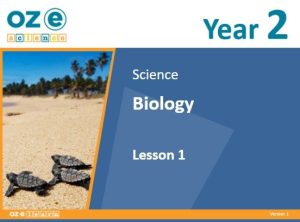
Year 2, Lesson 2
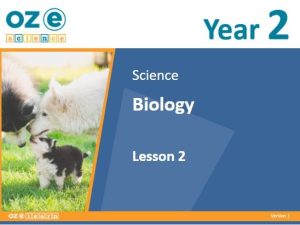
Teaching Resources
Extra resources
Australian Curriculum Content Descriptions
Overview
Biology Year 2 is a Biological Sciences unit for Year 2 students. It aligns to the Australian Curriculum Science Understanding:
- Living things grow and change and have offspring similar to themselves (ACSSU030).
Learning Objectives
In Lessons 1 to 9, students learn about:
- building a small pond ecosystem and identifying what an ecosystem provides living things with so they can live, grow and change
- identifying that animals, including humans, have offspring that look similar to their parents and things that have stayed the same and things that have changed as animals, including humans, grow
- micro-organisms and the microscopic living things in pond water
- how sea monkeys grow and change and sequencing the life stages of animals as they grow and change
- meta-morphosis and sequencing the life stages of insects and amphibians and compare the different stages as they grow and change
- features of plants as they grow and change and comparing these features
- what plants need to grow and change and how the features of plants help them grow and change
- a chosen animal, insect or amphibian studied, its life stages, and describe how it has changed
- creating a labelled model showing the different stages of a chosen animal
- completing a final assessment, reporting and communicating.
Success Criteria
- Represent a small pond ecosystem.
- Identify what an ecosystem provides living things with so they can live, grow and change.
- Identify offspring and how they are similar to their parents.
- Observe things that have changed and things that have stayed the same in animals, including how humans grow.
- Observe micro-organisms by completing scientific drawings.
- Observe the microscopic living things in pond water.
- Identify a sea monkey.
- Observe the life stages of a sea monkey.
- Sequence the life stages of animals as they grow and change.
- Identify metamorphosis.
- Observe the final stages of morphosis in the life cycle of a butterfly.
- Sequence the life stages of insects and amphibians and compare the stages as they grow and change.
- Analyse the features of plants as they grow and change.
- Compare the features of different plants.
- Identify the features of a plant.
- Compare the features of different plants.
- Identify what plants need to grow and change.
- Explain how the features of plants help them grow and change.
- Sequence the life stages of a chosen animal, insect or amphibian.
- Represent a labelled model showing the different stages of the chosen animal.
Assessment
Progress Tests
Progress tests are conducted after every second lesson, allowing teachers to monitor student understanding of the concepts taught over the past two lessons and to identify where reteaching is needed. The Teaching Guide contains the testing questions, and the Student Workbook has a section where students write their answers and score themselves.
Structured Research Activity
The Structured Research Activity (SRA) for this unit is as follows: Students create and present model showing the different life stages of their chosen animal. The SRA takes place over two lessons so students can apply the Science Understanding and Science Inquiry Skills covered in the unit. Teachers use the Guide to Making Judgements, which is included in the Teaching Guide, to mark the SRA.
End-of-Unit Assessment
The last lesson is the end-of-unit assessment, which has a variety of question formats (e.g. label the diagram, circle the correct answer) to assess student mastery of content from the unit. The end-of-unit assessment is in the Teaching Guide. Teachers copy the assessment and distribute to students at testing time.
Year 3
Year 3, Lesson 1
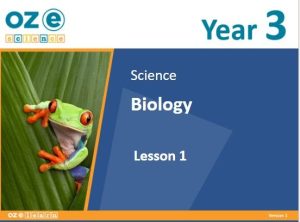
Year 3, Lesson 2
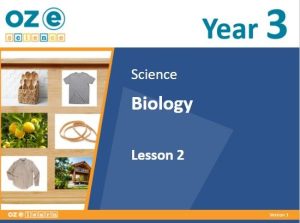
Teaching Resources
Extra resources
Australian Curriculum Content Descriptions
Overview
Biology Year 3 is a Biological Sciences unit for Year 3 students. It aligns to the Australian Curriculum Science Understanding:
- Living things can be grouped on the basis of observable features and can be distinguished from non-living things (ACSSU044).
Learning Objectives
In Lessons 1 to 9, students learn about:
- things that were once living but are now dead, and classifying living, non-living and once-living things that are now dead
- products that come from plants and classifying products from plants
- products that come from animals and representing products that come from animals
- observing and representing the features of plants and classifying them based on their observable features
- observing and representing the features of vertebrate animals and classifying them based on these features
- observing and representing the features of invertebrate animals and classifying them based on their observable features
- observing, representing and comparing the biodiversity in a habitat
- choosing and researching a chosen habitat, its biodiversity and describing any products that come from the plants and animals within it
- classifying the plants and animals from a chosen habitat and representing a scientific drawing of one plant and one animal
- completing a final assessment, reporting and communicating.
Success Criteria
- Observe and describe things that were once living but are now dead.
- Classify living, non-living and once-living things that are now dead.
- Observe and describe products that come from plants.
- Classify products that come from plants.
- Observe and describe products that come from animals.
- Represent the products that come from animals on a poster.
- Observe the features of plants and represent them in scientific drawings on a schoolyard exploration.
- Classify plants by their observable features.
- Observe the features of vertebrate animals.
- Classify vertebrate animals by their observable features.
- Observe and represent the features of invertebrate animals and represent them through scientific drawings.
- Classify invertebrate animals by their observable features.
- Observe and represent the biodiversity in a habitat.
- Compare the different habitats and the biodiversity within them.
- Research the biodiversity in a chosen habitat.
- Describe any products that come from the plants and animals within the habitat.
- Classify the biodiversity in a chosen habitat.
- Represent a plant and an animal in a scientific drawing.
Assessment
Progress Tests
Progress tests are conducted after every second lesson, allowing teachers to monitor student understanding of the concepts taught over the past two lessons and to identify where reteaching is needed. The Teaching Guide contains the testing questions, and the Student Workbook has a section where students write their answers and score themselves.
Structured Research Activity
The Structured Research Activity (SRA) for this unit is:
Students create and present a scientific drawing of one of the plants and one of the animals of their choice. The SRA takes place over two lessons so students can apply the Science Understanding and Science Inquiry Skills covered in the unit. Teachers use the Guide to Making Judgements, which is included in the Teaching Guide, to mark the SRA.
End-of-Unit Assessment
The last lesson is the end-of-unit assessment, which has a variety of question formats (e.g. label the diagram, circle the correct answer) to assess student mastery of content from the unit. The end-of-unit assessment is in the Teaching Guide. Teachers copy the assessment and distribute to students at testing time.
Year 4
Year 4, Lesson 1
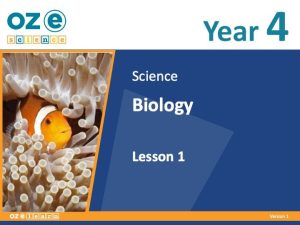
Year 4, Lesson 2
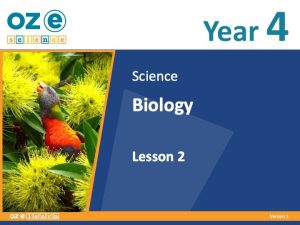
Teaching Resources
Extra resources
Australian Curriculum Content Descriptions
Overview
Biology Year 4 is a Biological Sciences unit for Year 4 students. It aligns to the Australian Curriculum Science Understanding:
- Living things depend on each other and the environment to survive (ACSSU074).
- Living things have life cycles (ACSSU072).
Learning Objectives
In Lessons 1 to 9, students learn about:
- the symbiotic relationships where both living things benefit – mutualism
- the symbiotic relationships between flowering plants and pollinators where both living things benefit – mutualism
- the three steps to asking questions about the world around us
- the symbiotic relationships where one living thing benefits and the other living thing does not benefit and is not harmed – commensalism
- the scientific method Charles Darwin followed when he observed, questioned and hypothesised about the possible pollinator of an unusual plant
- the symbiotic relationships where one living thing benefits and the other living thing is harmed – parasitism
- the life cycles of plants. the life cycles of animals, including metamorphosis
- completing reading research about a chosen living thing
- creating a documentary about your chosen living thing.
Success Criteria
- Observe mutual relationships between two living things.
- Report on a mutual relationship between two living things.
- Observe mutual relationships between flowering plants and pollinators.
- Sequence the steps of pollination in a storyboard.
- Observe commensal relationships between living things.
- Complete a table showing the benefit to the living thing.
- Observe, question and hypothesis what Charles Darwin did.
- Represent a scientific drawing.
- Observe parasitic relationships between two living things.
- Report on two parasitic relationships.
- Sequence the life cycle of a plant.
- Write a short report about the lifecycle of a plant.
- Conduct an experiment.
- Sequence the life cycle of an animal.
- Write a short report about the life cycle of an animal.
- Complete reading research on your chosen living thing.
- Create a documentary on your chosen living thing.
Assessment
Progress Tests
Progress tests are conducted after every second lesson, allowing teachers to monitor student understanding of the concepts taught over the past two lessons and to identify where reteaching is needed. The Teaching Guide contains the testing questions, and the Student Workbook has a section where students write their answers and score themselves.
Structured Research Activity
The Structured Research Activity (SRA) for this unit is: Students conduct research at a local geological site and record, report and present findings. The SRA takes place over two lessons so students can apply the Science Understanding and Science Inquiry Skills covered in the unit. Teachers use the Guide to Making Judgements, which is included in the Teaching Guide, to mark the SRA.
End-of-Unit Assessment
The last lesson is the end-of-unit assessment, which has a variety of question formats (e.g. label the diagram, circle the correct answer) to assess student mastery of content from the unit. The end-of-unit assessment is in the Teaching Guide. Teachers copy the assessment and distribute to students at testing time.
Year 5
Year 5, Lesson 1
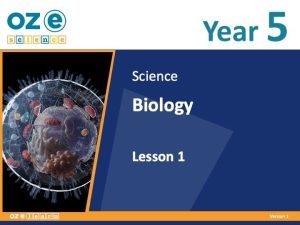
Year 5, Lesson 2
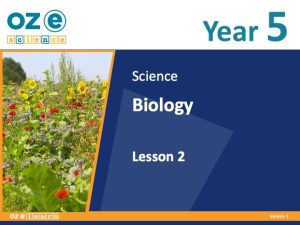
Teaching Resources
Extra resources
Australian Curriculum Content Descriptions
Overview
Biology Year 5 is a Biological Sciences curriculum program for Year 5 students. It aligns to the Australian Curriculum Science Understanding:
- Living things depend on each other and the environment to survive (ACSSU074).
- Living things have life cycles (ACSSU072).
Learning Objectives
In Lessons 1 to 9, students learn about:
- how all life started as a single cell
- the species that form Earth’s biodiversity
- different environments having different physical conditions
- natural selection and adaptations
- the adaptations to biological conditions in the environment
- how living things survive in extreme conditions
- how to use the scientific method to find out which animals and plants live in your local environment
- how to conduct research in our schoolyard to find out which animals and plants live there and to observe their adaptations
- how to explain and evaluate the results of your research about the adaptations of living things in your area.
Success Criteria
- Describe the fundamental unit of life – the cell.
- Explain how single living cells came to be.
- Explain that all life forms today descended from a single cell.
- Represent a cell and its contents.
- Describe how scientists sort and classify the huge diversity of living things.
- Explain what a species is.
- Explain what living things need to survive.
- Describe how environments differ in their physical locations.
- Analyse the physical conditions in a local environment.
- Explain what natural selection is.
- Explain what an adaptation is.
- Investigate how natural selection leads to adaptations.
- Describe how environments differ in their biological conditions.
- Explain what adaptations animals and plants have to biological conditions.
- Represent an animal adapted to biological conditions.
- Explain why extreme conditions make it difficult to survive.
- Describe the adaptations to survive in extreme drought and cold.
- Represent an animal adapted to living in extreme conditions.
- Research which types of living things live in your chosen environment.
- Describe which types of living things live in your chosen environment.
- Describe the ‘plan’ and ‘conduct’ steps of the scientific method.
- Research which types of living things live in our schoolyard.
- Observe and record the adaptations that living things in the schoolyard might have.
- Explain the results of your investigation.
- Report the results of your investigation.
- Communicate your findings to an audience.
Assessment
Progress Tests
Progress tests are conducted after every second lesson, allowing teachers to monitor student understanding of the concepts taught over the past two lessons and to identify where reteaching is needed. The Teaching Guide contains the testing questions, and the Student Workbook has a section where students write their answers and score themselves.
Structured Research Activity
The Structured Research Activity (SRA) for this unit is: Students observe, record, research and report on at least two plants and two animals and their adaptations. The SRA takes place over two lessons so students can apply the Science Understanding and Science Inquiry Skills covered in the unit. Teachers use the Guide to Making Judgements, which is included in the Teaching Guide, to mark the SRA.
End-of-Unit Assessment
The last lesson is the end-of-unit assessment, which has a variety of question formats (e.g. label the diagram, circle the correct answer) to assess student mastery of content from the unit. The end-of-unit assessment is in the Teaching Guide. Teachers copy the assessment and distribute to students at testing time.
Year 6
Year 6, Lesson 1
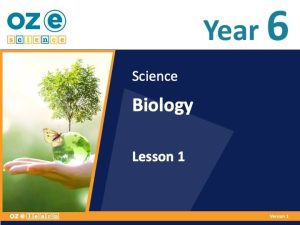
Year 6, Lesson 2
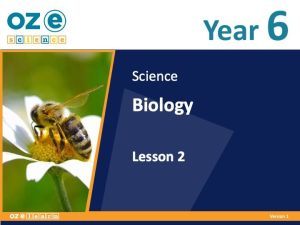
Teaching Resources
Extra resources
Australian Curriculum Content Descriptions
Overview
Biology Year 6 is a Biological Sciences curriculum program for Year 6 students. It aligns to the Australian Curriculum Science Understanding:
- The growth and survival of living things are affected by the physical conditions of their environment. (ACSSU094)
Learning Objectives
In Lessons 1 to 9, students learn about:
- how to identify the unique conditions on Earth that have allowed the creation of life
- how to identify the characteristics of a living thing
- how to identify the conditions living things need in order to survive
- how to plan and set up an experiment to determine the effect of changing conditions on a plant species
- how to identify different types of microscopic life and the conditions they need to survive
- how to explain why controlling factors and conditions for growing bacteria and fungi are important for our own survival
- how to identify the effects of the coronavirus and how it affects humans
- how to observe and record an experiment to determine the effect of changing conditions on a plant species
- how to explain, evaluate and communicate the results of an experiment to determine the effect of changing conditions on a plant species.
Success Criteria
- Identify the conditions on Earth that allowed life to form.
- Describe four theories about how life formed on Earth.
- Experiment with creating energy from mixing chemicals.
- Describe what makes something ‘living’.
- Identify the characteristics of living things.
- Create a model of a living thing.
- Describe the conditions required for humans to survive.
- Explain what happens to humans outside of these conditions.
- Identify different types of life that live in different conditions.
- Describe the conditions for plant survival.
- Explain how to set up a fair test.
- Set up an experiment to test plant survival.
- Describe what microorganisms are and their growing conditions.
- Explain how a microscope can help us see microorganisms.
- Identify microorganisms in a sample of pond water.
- Explain how bacteria and fungi grow rapidly in perfect conditions.
- Describe ways of controlling the conditions to control the growth of bacteria and fungi.
- Investigate the growth of fungi in different conditions.
- Explain how viruses affect their host.
- Identify ways to protect against viruses.
- Investigate how herd immunity can control the spread of viruses.
- Identify the conditions living things need to survive.
- Describe the result that changing a condition has on plant growth.
- Observe and record the results of an experiment.
- Explain the result of changing conditions on plant growth.
- Report the results of an experiment.
- Communicate the findings of an experiment.
Assessment
Progress Tests
Progress tests are conducted after every second lesson, allowing teachers to monitor student understanding of the concepts taught over the past two lessons and to identify where reteaching is needed. The Teaching Guide contains the testing questions, and the Student Workbook has a section where students write their answers and score themselves.
Structured Research Activity
The Structured Research Activity (SRA) for this unit is: Students conduct an experiment growing seeds and report on the effect of changing conditions on a plant species. The SRA takes place over two lessons so students can apply the Science Understanding and Science Inquiry Skills covered in the unit. Teachers use the Guide to Making Judgements, which is included in the Teaching Guide, to mark the SRA.
End-of-Unit Assessment
The last lesson is the end-of-unit assessment, which has a variety of question formats (e.g. label the diagram, circle the correct answer) to assess student mastery of content from the unit. The end-of-unit assessment is in the Teaching Guide. Teachers copy the assessment and distribute to students at testing time.
